Dickens
Topic with 95 items
|
Title
|
Images
|
Item Comment
|
Prefix
|
Number
|
In set
|
Set
|
Set Comment
|
Type
|
Artist
|
Author
|
Size
|
Topics
|
Set Covers
|
Reference
| |
|---|---|---|---|---|---|---|---|---|---|---|---|---|---|---|---|
| 81 |
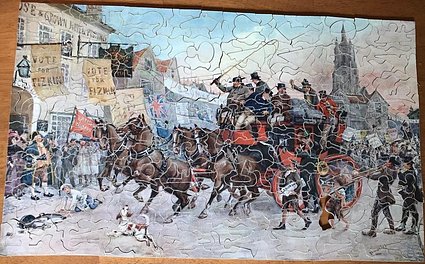


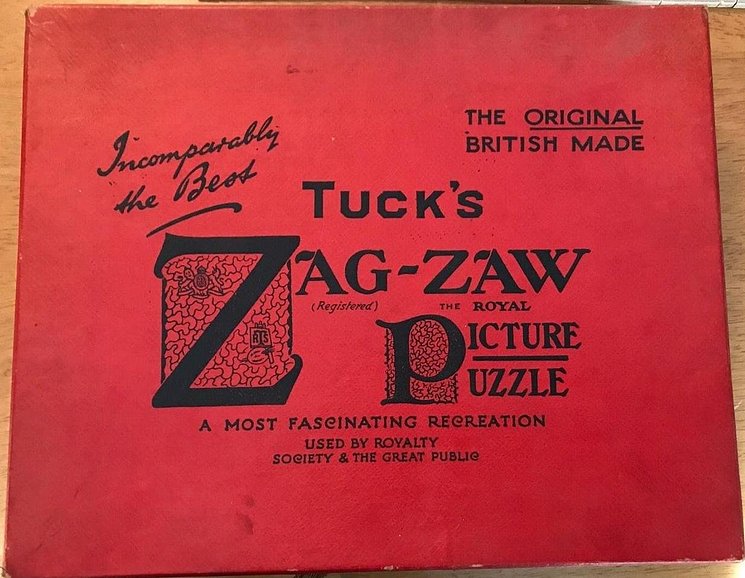
|
about 400 pieces
|
|
|
|
THE COACHING SERIES WAS CONCEIVED TO CELEBRATE THE 1912 CENTENNIAL OF CHARLES DICKENS.
|
|
|
20 x 12 in.
|
|
| ||||
| 82 |
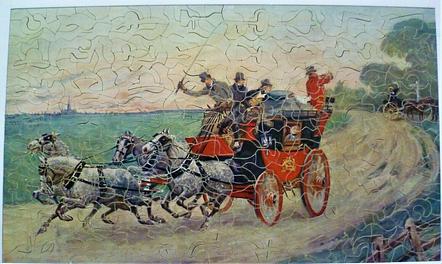



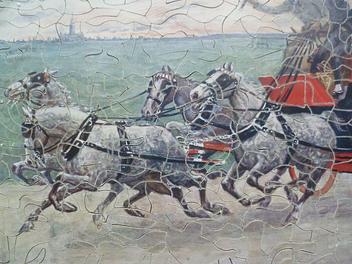
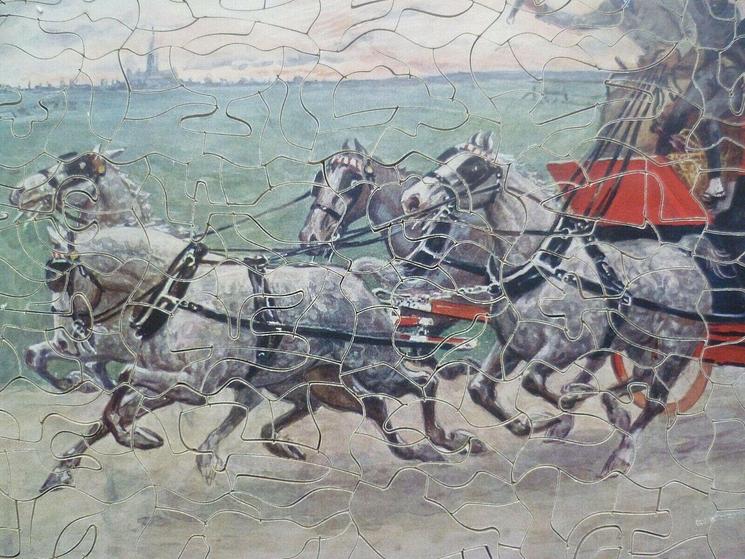



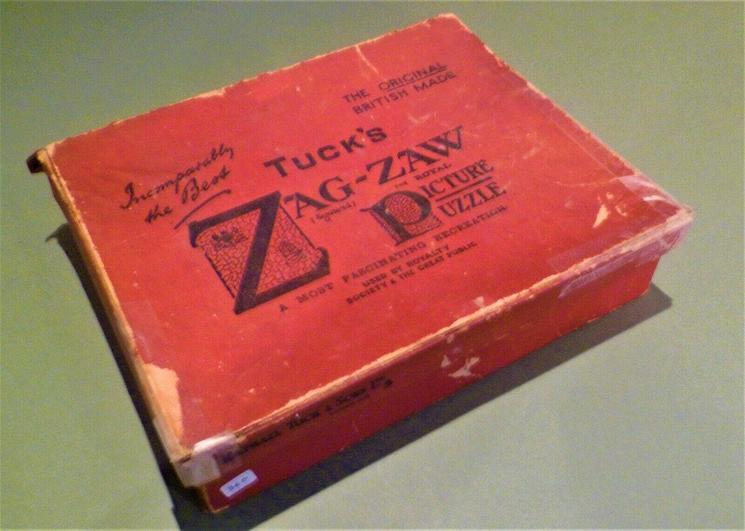
|
420 pieces, wooden, figurals, complete, with box, circa 1930's
|
|
|
|
THE COACHING SERIES WAS CONCEIVED TO CELEBRATE THE 1912 CENTENNIAL OF CHARLES DICKENS.
|
A. LUDOVICI
|
|
49 x 29 cm.
|
|
| ||||
| 83 |
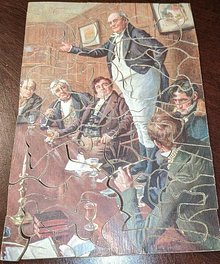

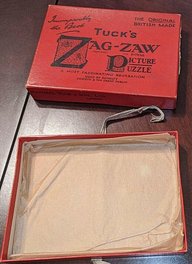



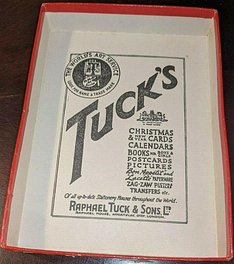

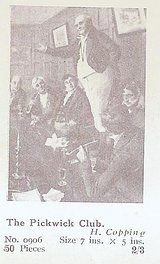
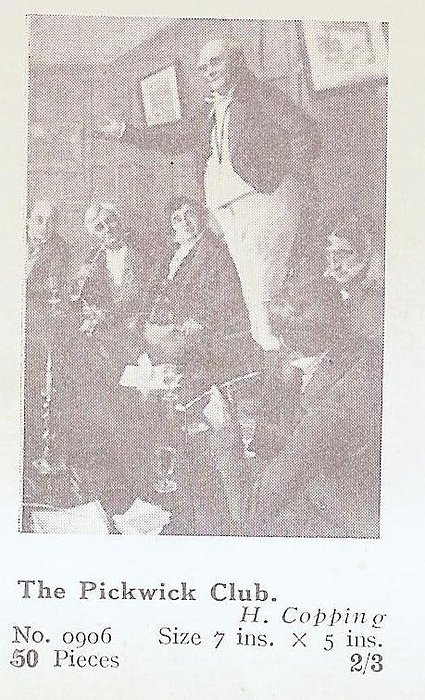
|
50 pieces, wooden, figurals, complete with box, push fit style, also comes in an unnumbered version
|
|
906
|
|
Zag-Zaw line of puzzles was first produced in 1909, most incorporate figurals or whimsies, sold in red, orange, or occasionally green boxes with labels on the side or bottom of the box, most without guide pictures. Initially cut non-interlocking but by 1930's became more so. Puzzles have a different cuts so that the same image will come in several versions which means that missing pieces can not be taken from other puzzles with the same image. The puzzle labels are often hand written and come with minor variations in titles and details. Some have a DESIGN catergory on the label. From my readings this refers to the style of cut, wavy lines, figurals, etc. See also Bob Armstrong's website on old jigsaw puzzles
|
H. COPPING
|
|
5 x 7 in.
|
|
| ||||
| 84 |
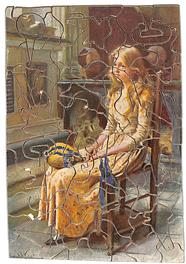

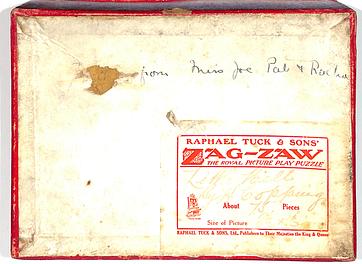



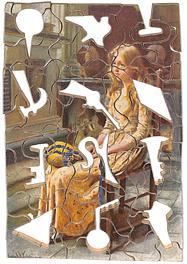
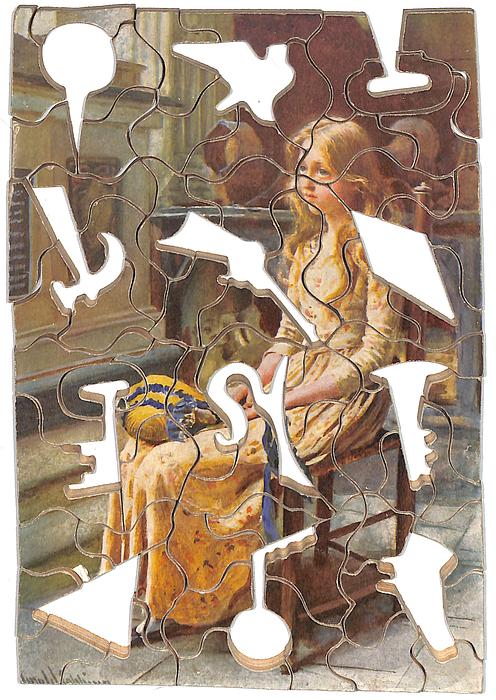
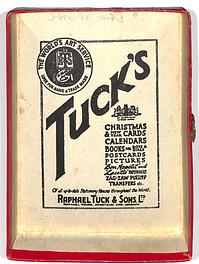
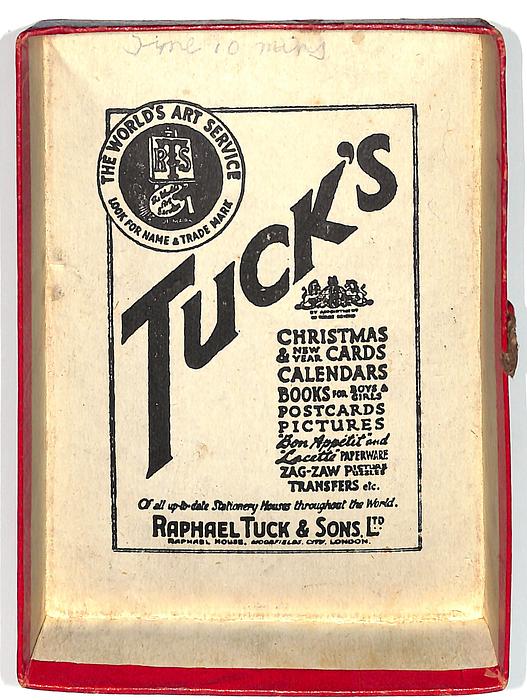
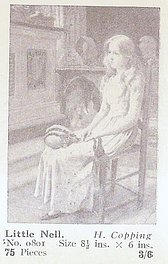

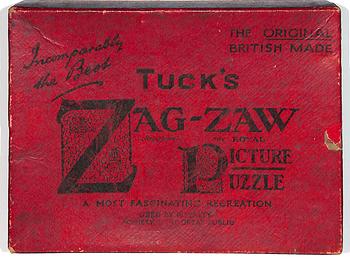
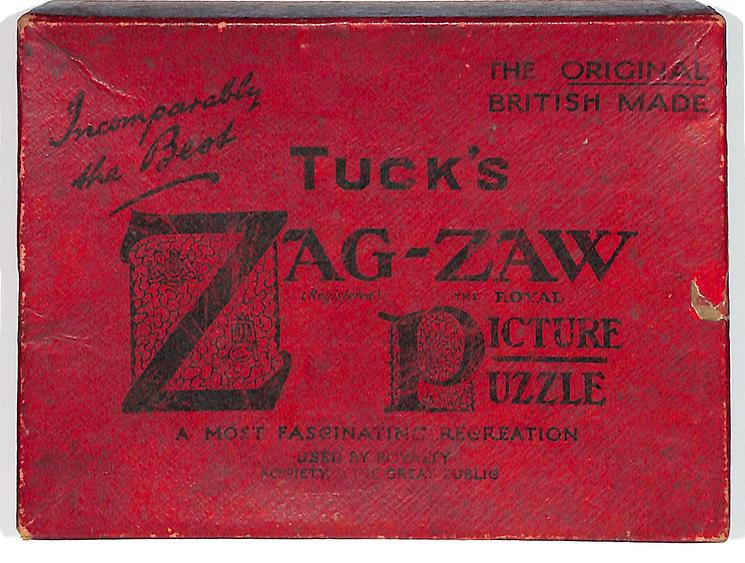
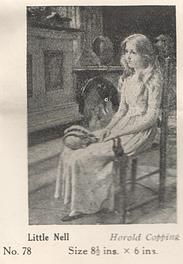
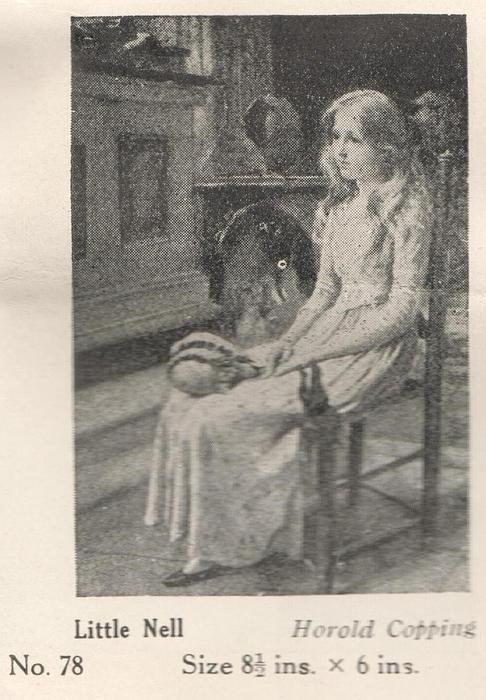
|
about 75 pieces, wooden, figurals, complete with box, push fit style, listed and described in the catalogs as number 78 or 0801 depending on the catalog
|
|
|
|
Zag-Zaw line of puzzles was first produced in 1909, most incorporate figurals or whimsies, sold in red, orange, or occasionally green boxes with labels on the side or bottom of the box, most without guide pictures. Initially cut non-interlocking but by 1930's became more so. Puzzles have a different cuts so that the same image will come in several versions which means that missing pieces can not be taken from other puzzles with the same image. The puzzle labels are often hand written and come with minor variations in titles and details. Some have a DESIGN catergory on the label. From my readings this refers to the style of cut, wavy lines, figurals, etc. See also Bob Armstrong's website on old jigsaw puzzles
|
H. COPPING
|
|
6 x 8.1/2 in.
|
|
| ||||
| 85 |
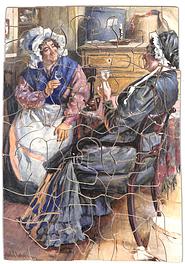
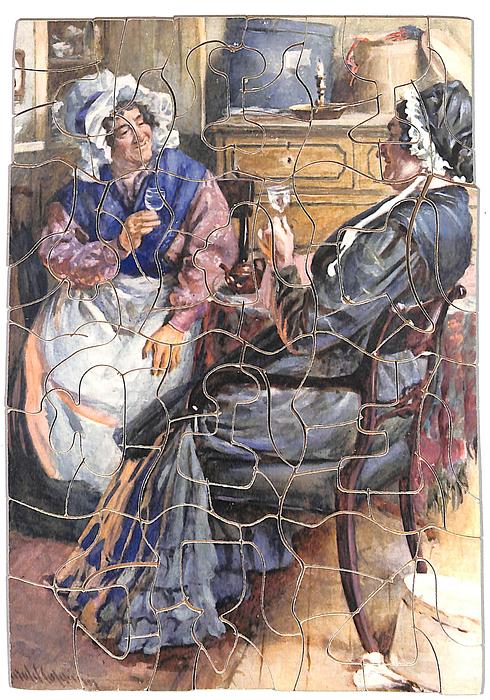
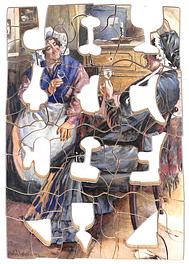

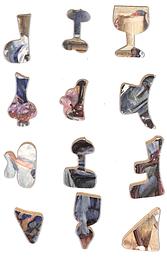

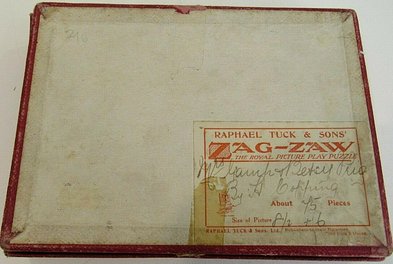
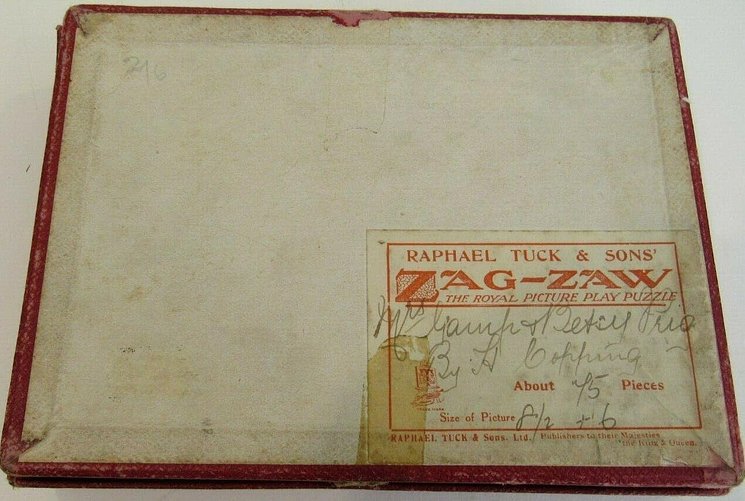
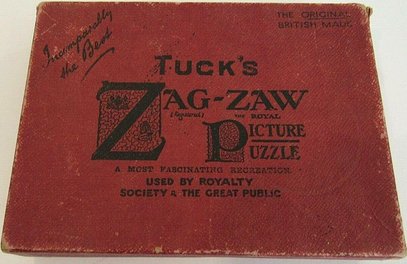
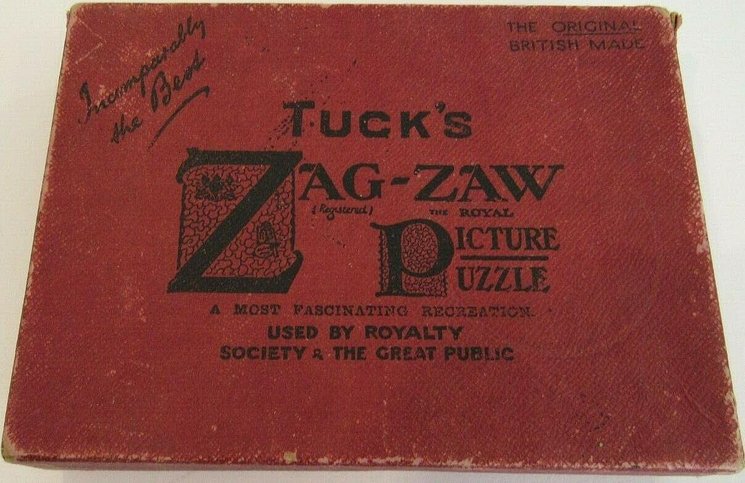
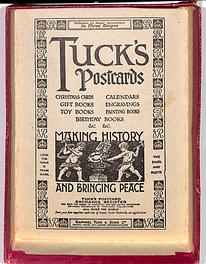
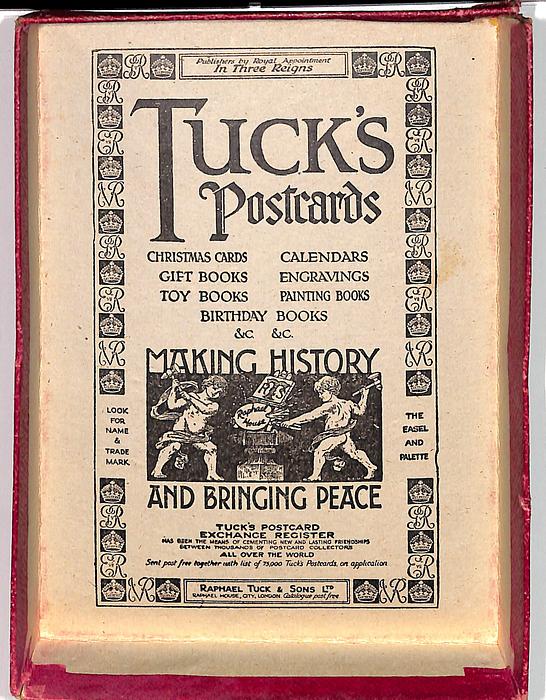
|
about 75 pieces, twelve figurals, wooden, complete with box, push fit style
|
|
|
|
Zag-Zaw line of puzzles was first produced in 1909, most incorporate figurals or whimsies, sold in red, orange, or occasionally green boxes with labels on the side or bottom of the box, most without guide pictures. Initially cut non-interlocking but by 1930's became more so. Puzzles have a different cuts so that the same image will come in several versions which means that missing pieces can not be taken from other puzzles with the same image. The puzzle labels are often hand written and come with minor variations in titles and details. Some have a DESIGN catergory on the label. From my readings this refers to the style of cut, wavy lines, figurals, etc. See also Bob Armstrong's website on old jigsaw puzzles
|
HAROLD COPPING
|
|
5 3/4 x 8 1/4 in.
|
|
| ||||
| 86 |
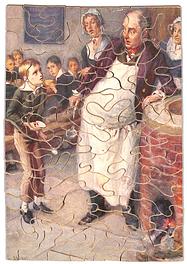

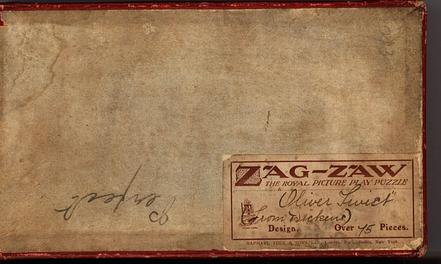
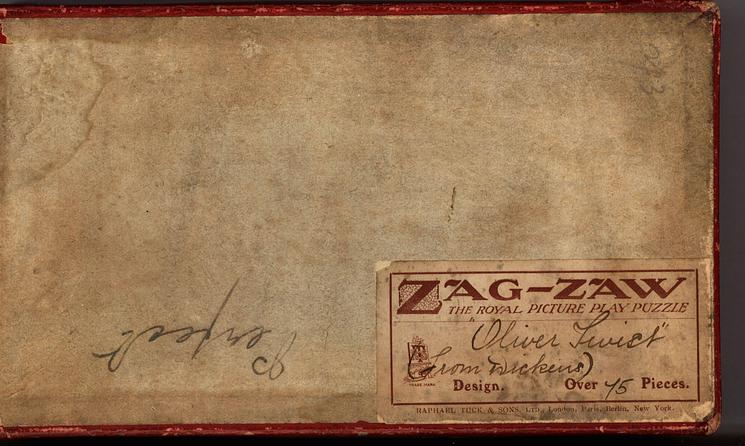
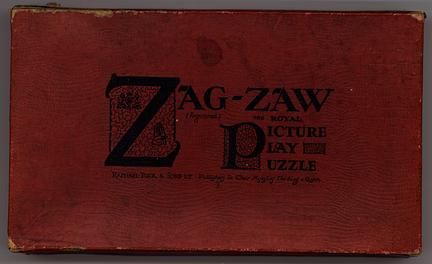
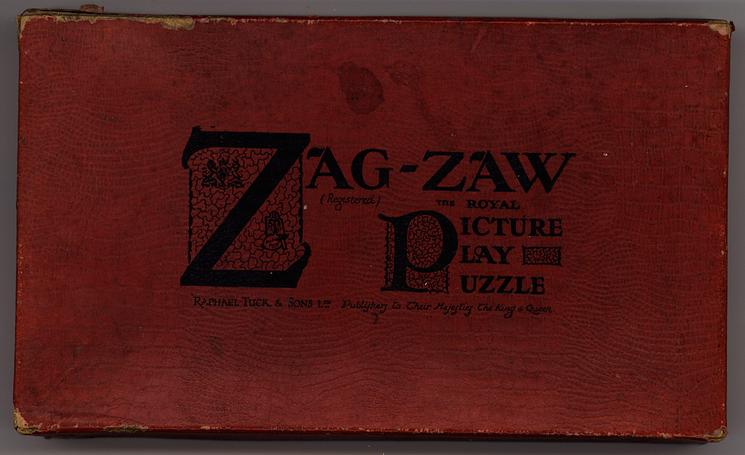
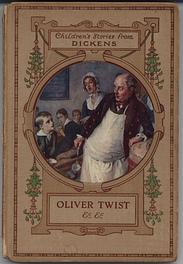
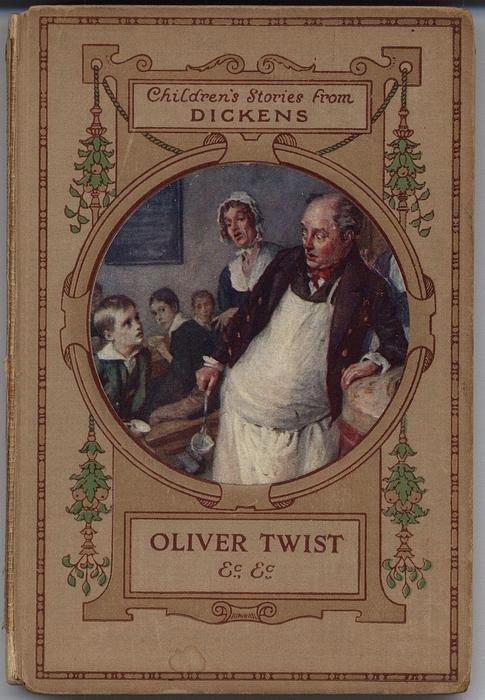


|
about 75 pieces, wooden, no figurals, complete with box, push fit style also titled in another version of the puzzle as OLIVER TWIST ASKING FOR MORE, numbered 814 same image used in many other Tuck ephemera items
|
|
|
|
Zag-Zaw line of puzzles was first produced in 1909, most incorporate figurals or whimsies, sold in red, orange, or occasionally green boxes with labels on the side or bottom of the box, most without guide pictures. Initially cut non-interlocking but by 1930's became more so. Puzzles have a different cuts so that the same image will come in several versions which means that missing pieces can not be taken from other puzzles with the same image. The puzzle labels are often hand written and come with minor variations in titles and details. Some have a DESIGN catergory on the label. From my readings this refers to the style of cut, wavy lines, figurals, etc. See also Bob Armstrong's website on old jigsaw puzzles
|
HAROLD COPPING
|
|
5 1/2 x 8 in.
|
|
| ||||
| 87 |
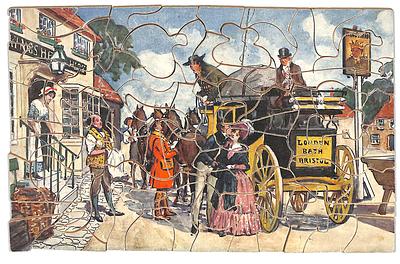

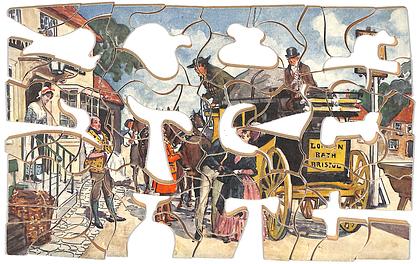

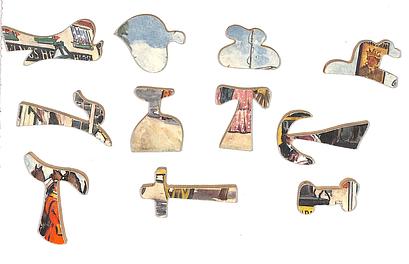

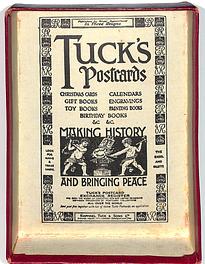
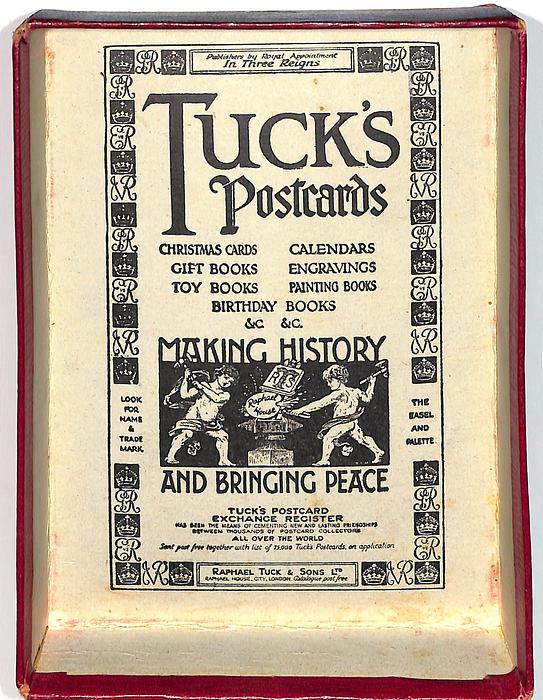

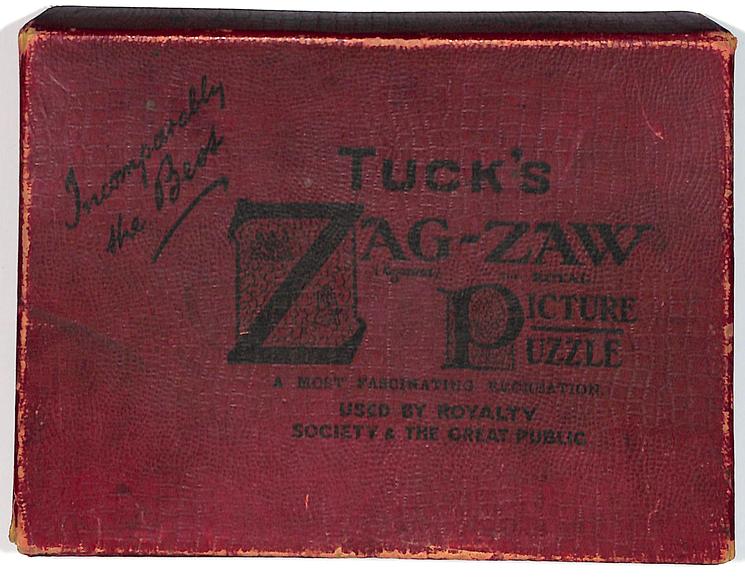
|
about 75 pieces, wooden, figurals, complete with box (no label), push fit style
|
|
|
|
Zag-Zaw line of puzzles was first produced in 1909, most incorporate figurals or whimsies, sold in red, orange, or occasionally green boxes with labels on the side or bottom of the box, most without guide pictures. Initially cut non-interlocking but by 1930's became more so. Puzzles have a different cuts so that the same image will come in several versions which means that missing pieces can not be taken from other puzzles with the same image. The puzzle labels are often hand written and come with minor variations in titles and details. Some have a DESIGN catergory on the label. From my readings this refers to the style of cut, wavy lines, figurals, etc. See also Bob Armstrong's website on old jigsaw puzzles
|
A. LUDOVICI
|
|
8 1/2 x 5 1/2 in.
|
|
| ||||
| 88 |
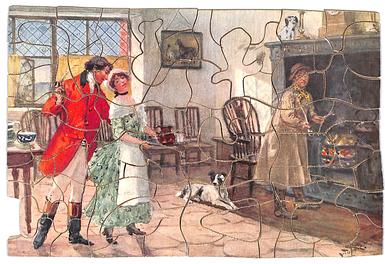
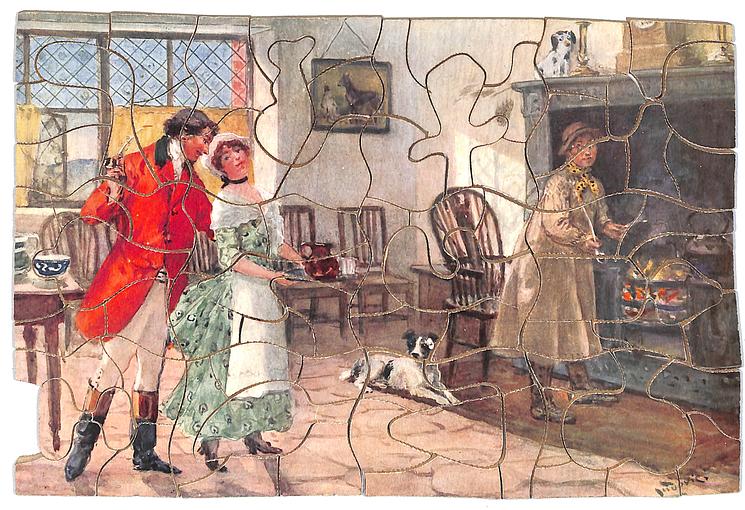
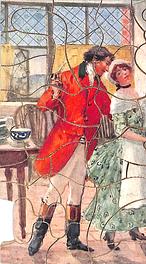
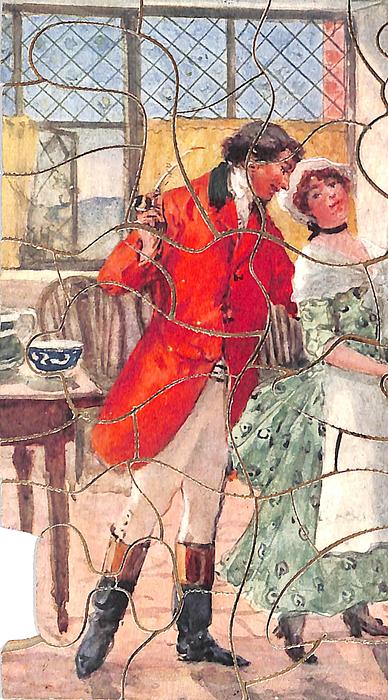
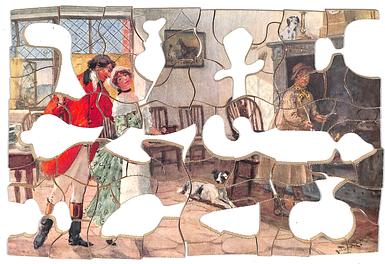
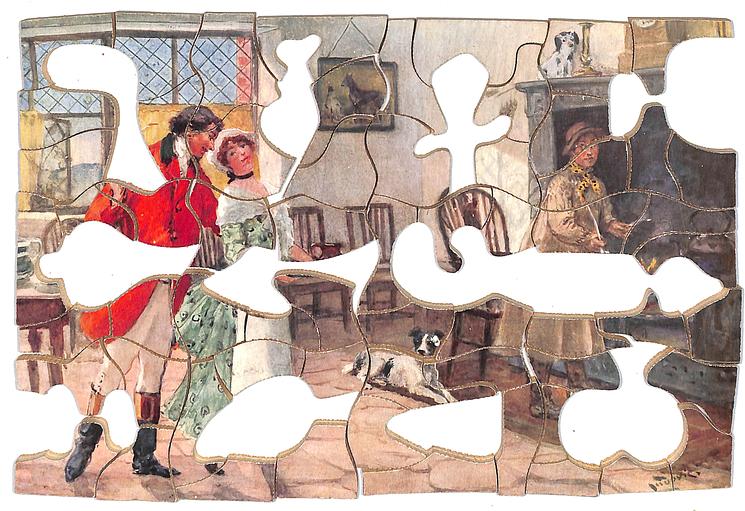

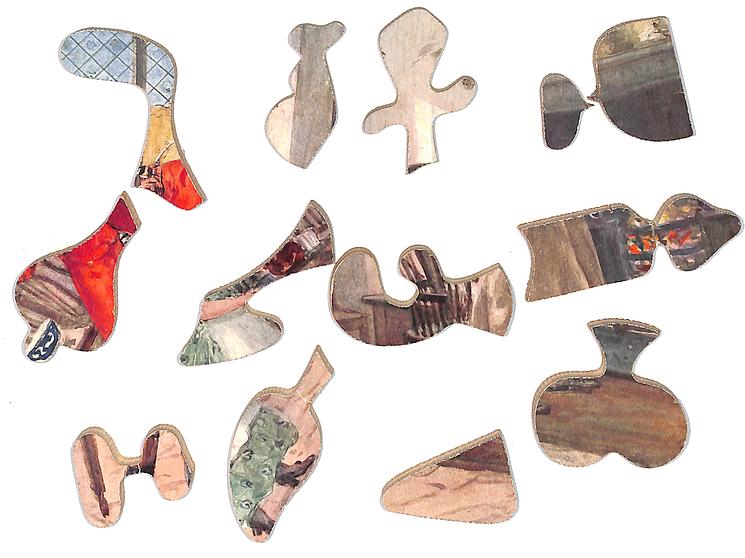
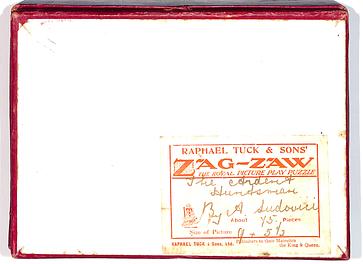
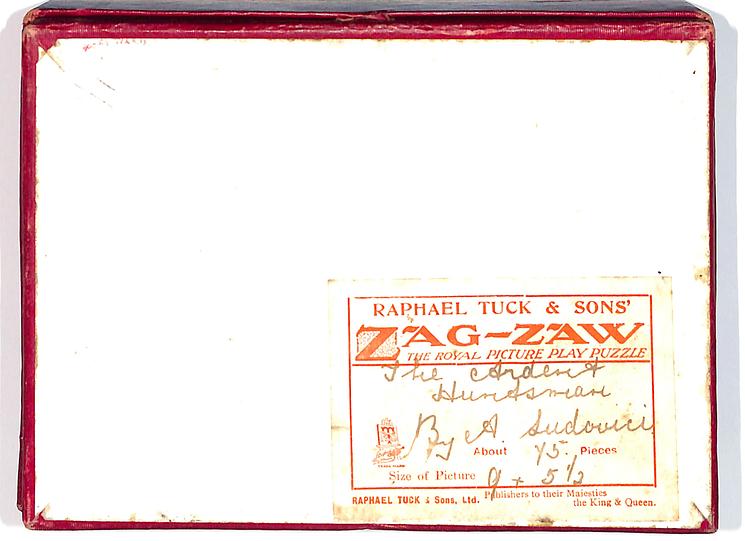
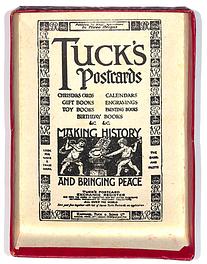

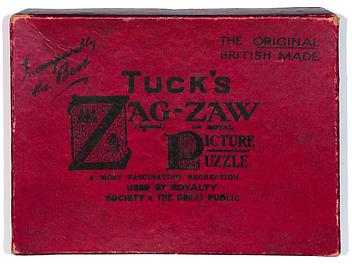
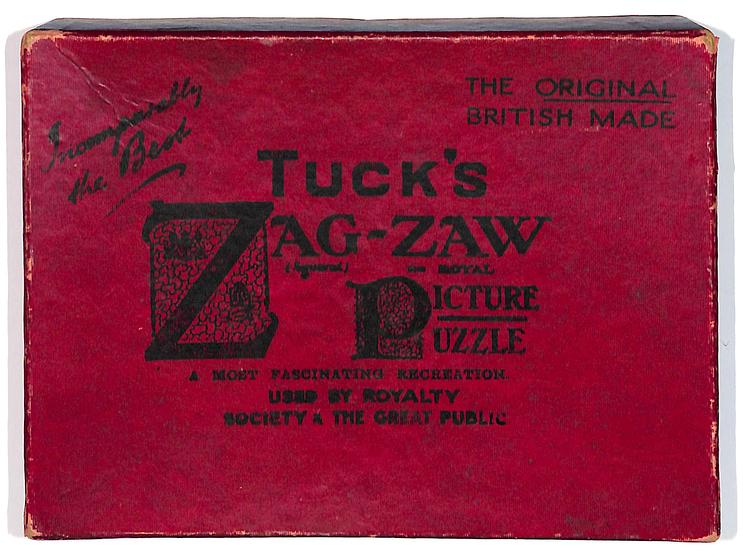
|
about 75 pieces, wooden, figurals, with box, one piece missing, one broken, and one glued, push fit style
|
|
|
|
Zag-Zaw line of puzzles was first produced in 1909, most incorporate figurals or whimsies, sold in red, orange, or occasionally green boxes with labels on the side or bottom of the box, most without guide pictures. Initially cut non-interlocking but by 1930's became more so. Puzzles have a different cuts so that the same image will come in several versions which means that missing pieces can not be taken from other puzzles with the same image. The puzzle labels are often hand written and come with minor variations in titles and details. Some have a DESIGN catergory on the label. From my readings this refers to the style of cut, wavy lines, figurals, etc. See also Bob Armstrong's website on old jigsaw puzzles
|
A. LUDOVICI
|
|
9 3/4 x 6 1/2 in.
|
|
| ||||
| 89 |
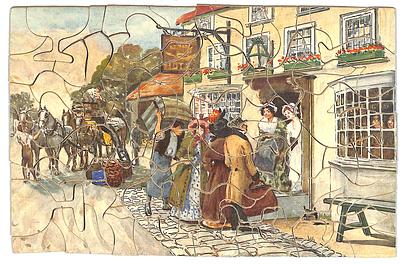

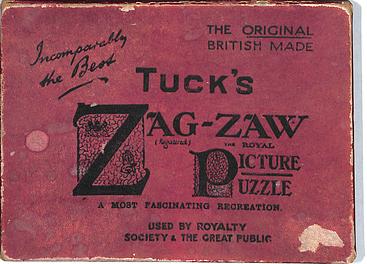
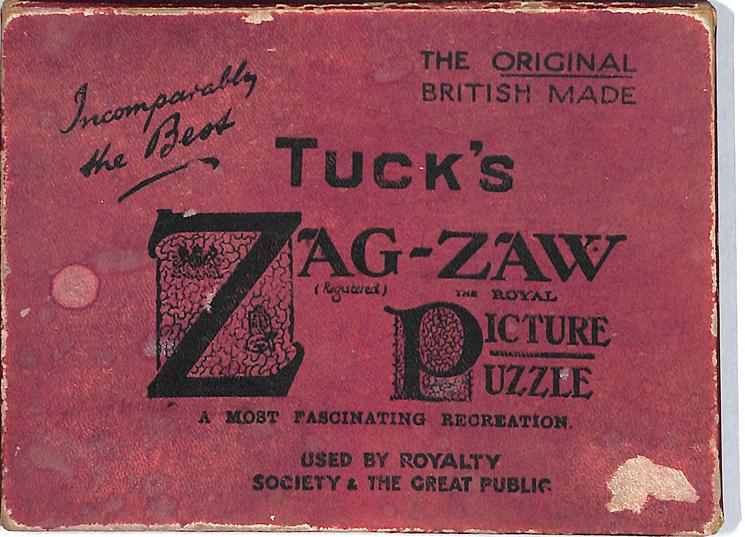

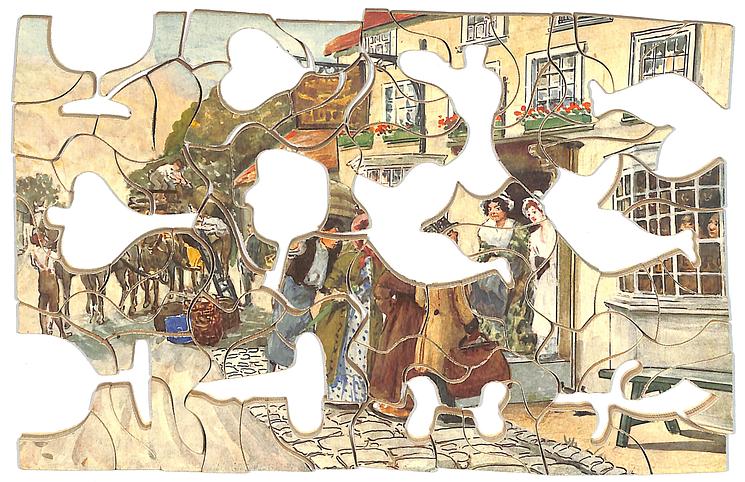
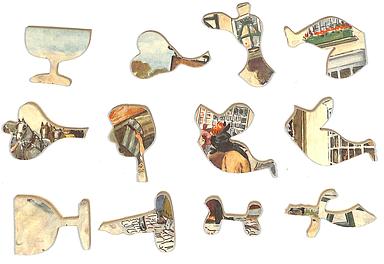

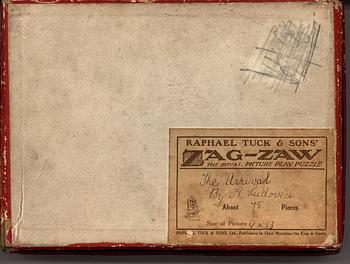

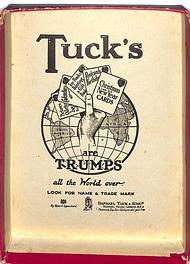
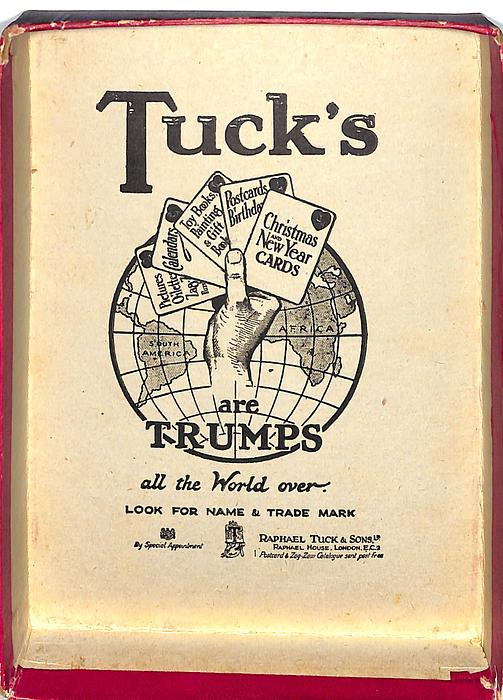

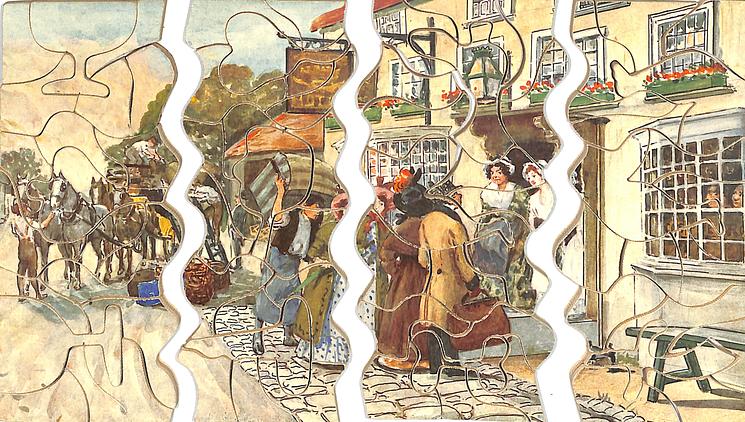
|
about 75 pieces, wooden, figurals, complete with box, push fit style, similar in style to the Dickens Coaching series
|
|
|
|
Zag-Zaw line of puzzles was first produced in 1909, most incorporate figurals or whimsies, sold in red, orange, or occasionally green boxes with labels on the side or bottom of the box, most without guide pictures. Initially cut non-interlocking but by 1930's became more so. Puzzles have a different cuts so that the same image will come in several versions which means that missing pieces can not be taken from other puzzles with the same image. The puzzle labels are often hand written and come with minor variations in titles and details. Some have a DESIGN catergory on the label. From my readings this refers to the style of cut, wavy lines, figurals, etc. See also Bob Armstrong's website on old jigsaw puzzles
|
A. LUDOVICI
|
|
8 1/2 x 5 1/2 in.
|
|
| ||||
| 90 |
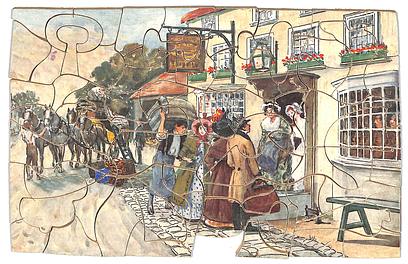



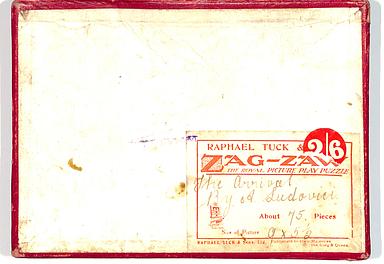
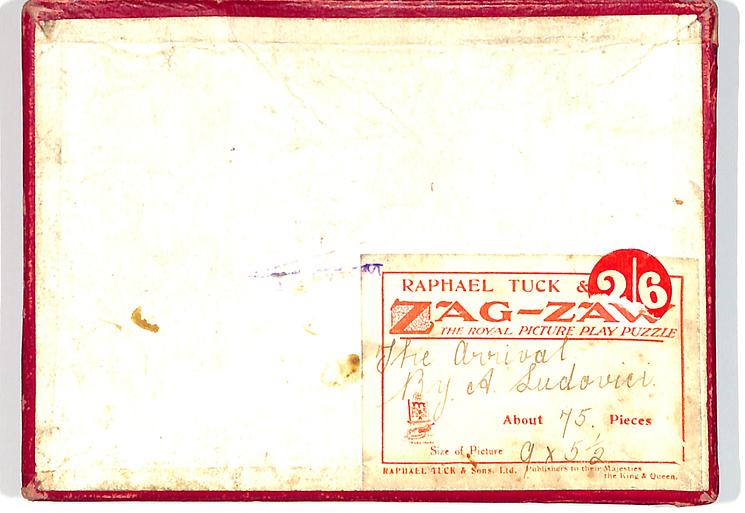
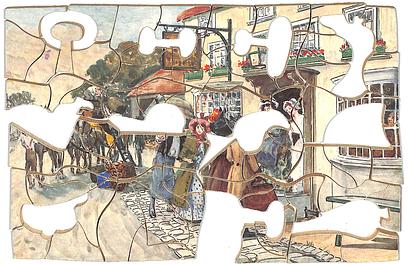

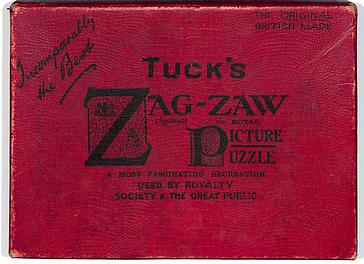
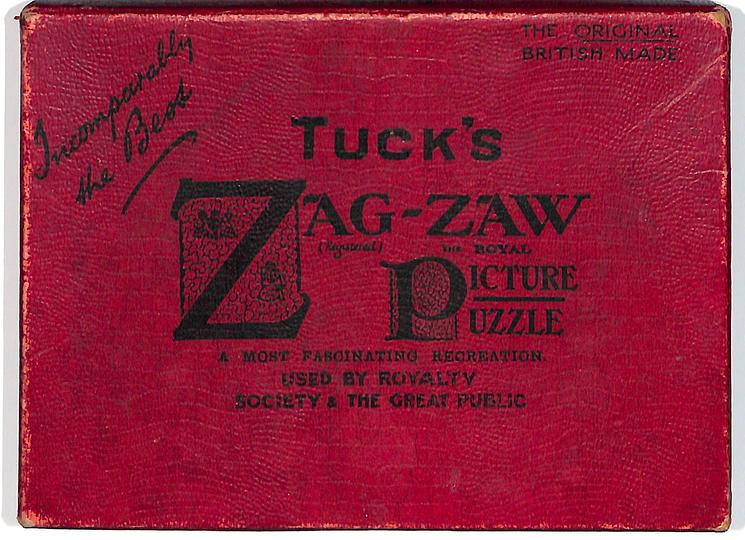
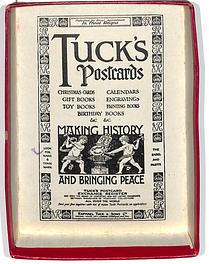
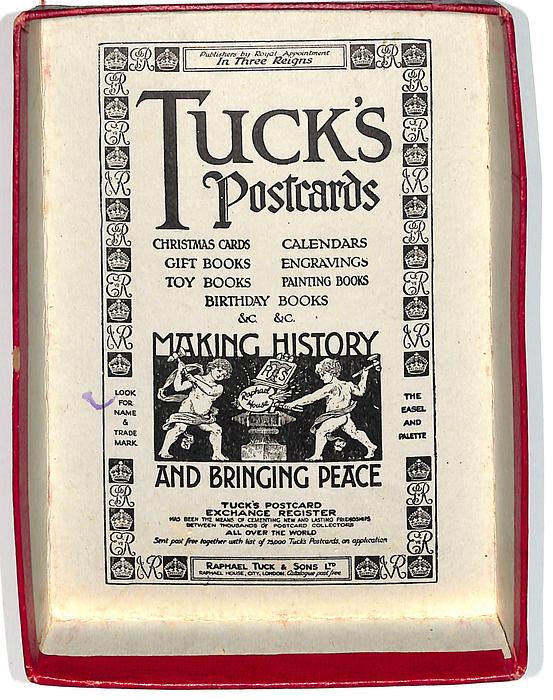
|
about 75 pieces, wooden, figurals, missing one piece, one piece broken but glued together, with box, push fit style
|
|
|
|
Zag-Zaw line of puzzles was first produced in 1909, most incorporate figurals or whimsies, sold in red, orange, or occasionally green boxes with labels on the side or bottom of the box, most without guide pictures. Initially cut non-interlocking but by 1930's became more so. Puzzles have a different cuts so that the same image will come in several versions which means that missing pieces can not be taken from other puzzles with the same image. The puzzle labels are often hand written and come with minor variations in titles and details. Some have a DESIGN catergory on the label. From my readings this refers to the style of cut, wavy lines, figurals, etc. See also Bob Armstrong's website on old jigsaw puzzles
|
A. LUDOVICI
|
|
9 x 5 3/4 in.
|
|
| ||||
| 91 |
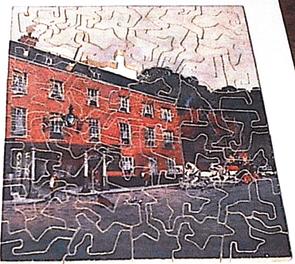
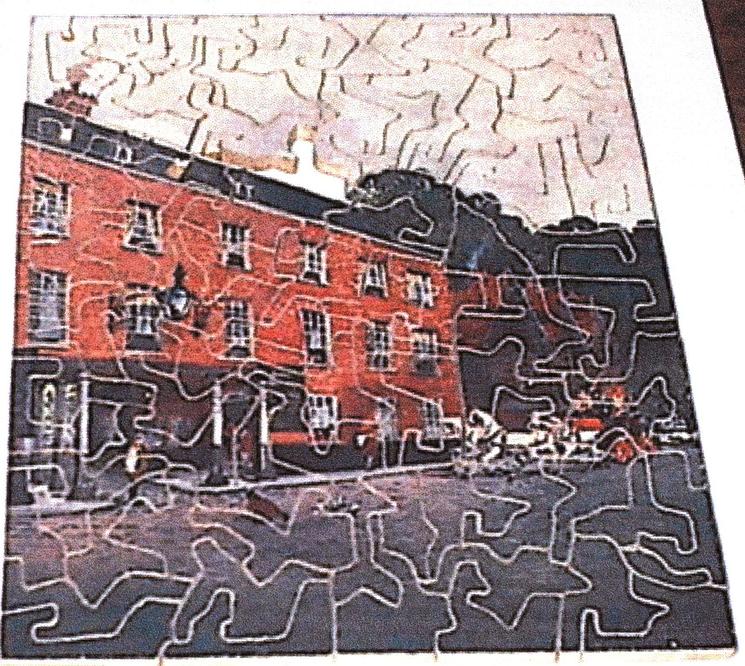
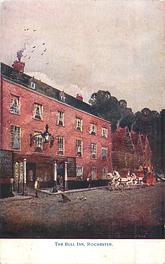
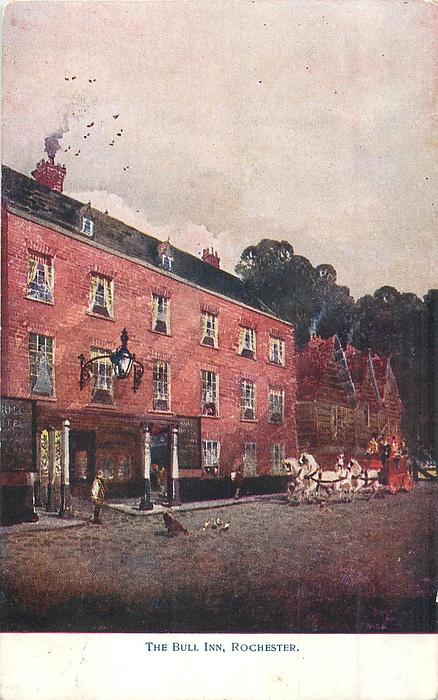
|
about 51-99 pieces, possibly in wrong set for number of pieces, wooden, no figurals, missing one piece, with box, push fit style, this same image comes as a Tuck's reward card
|
|
|
|
Zag-Zaw line of puzzles was first produced in 1909, most incorporate figurals or whimsies, sold in red, orange, or occasionally green boxes with labels on the side or bottom of the box, most without guide pictures. Initially cut non-interlocking but by 1930's became more so. Puzzles have a different cuts so that the same image will come in several versions which means that missing pieces can not be taken from other puzzles with the same image. The puzzle labels are often hand written and come with minor variations in titles and details. Some have a DESIGN catergory on the label. From my readings this refers to the style of cut, wavy lines, figurals, etc. See also Bob Armstrong's website on old jigsaw puzzles
|
|
|
|
|
| ||||
| 92 |
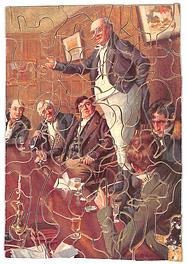
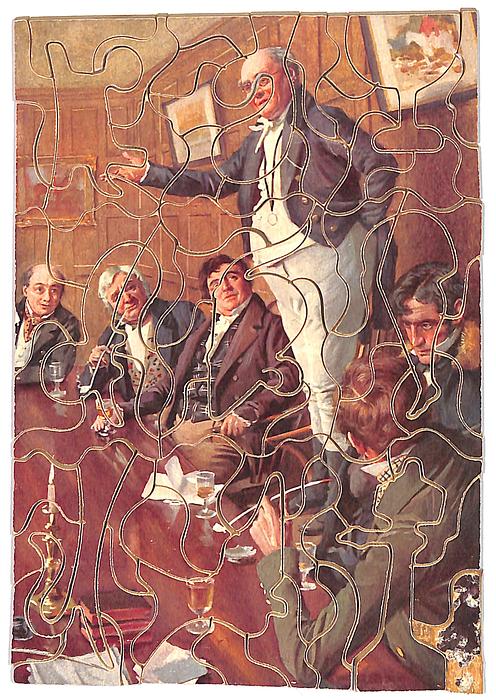
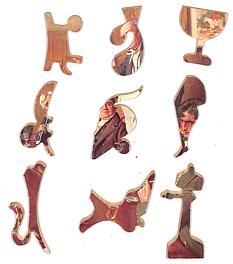

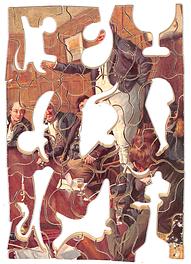
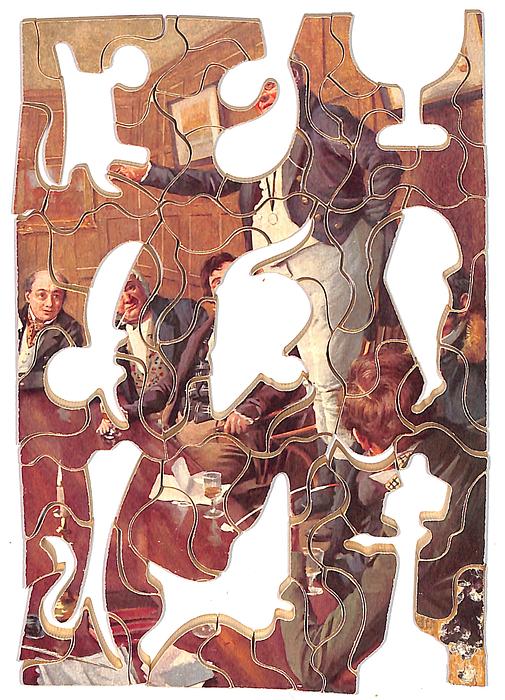


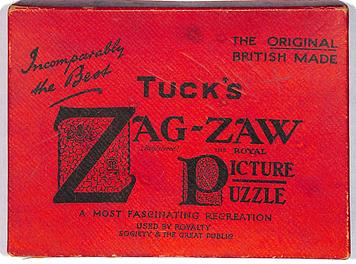
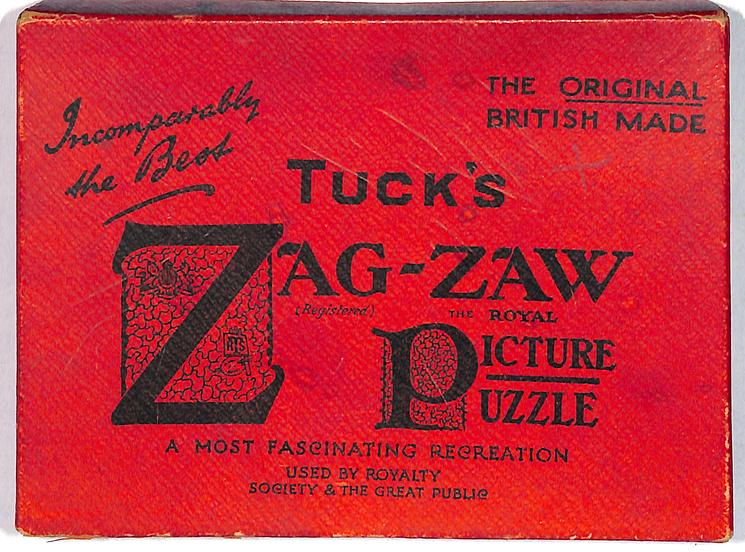
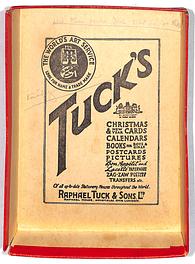
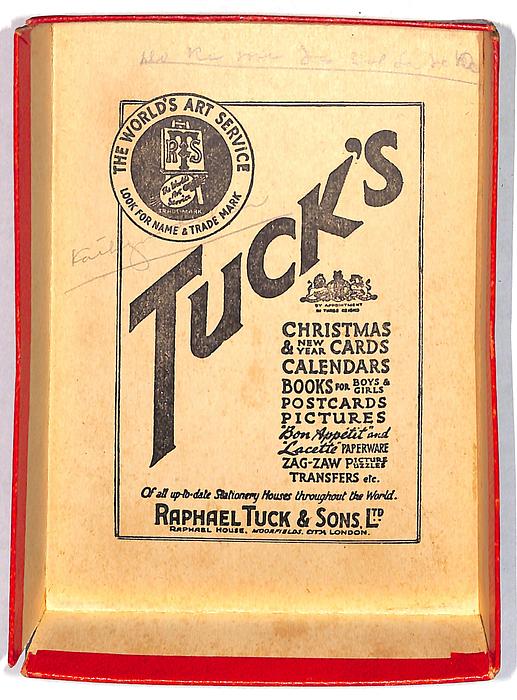
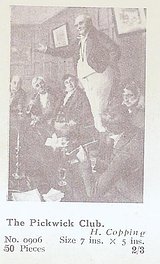
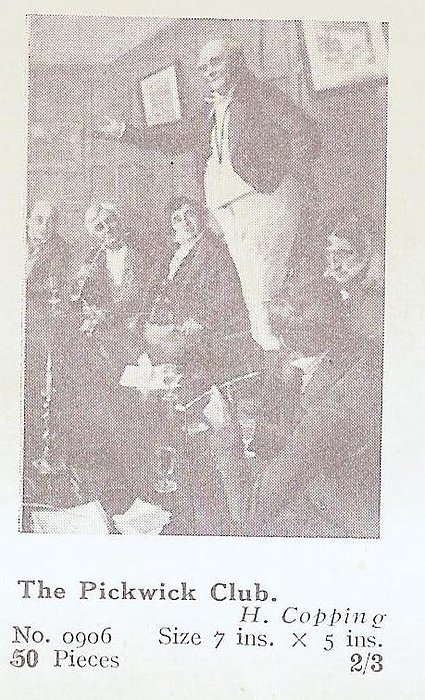
|
65 pieces, wooden, figurals, complete with box, one piece badly chewed, listed and described in the catalogs as being number 0906
|
|
|
|
Zag-Zaw line of puzzles was first produced in 1909, most incorporate figurals or whimsies, sold in red, orange, or occasionally green boxes with labels on the side or bottom of the box, most without guide pictures. Initially cut non-interlocking but by 1930's became more so. Puzzles have a different cuts so that the same image will come in several versions which means that missing pieces can not be taken from other puzzles with the same image. The puzzle labels are often hand written and come with minor variations in titles and details. Some have a DESIGN catergory on the label. From my readings this refers to the style of cut, wavy lines, figurals, etc. See also Bob Armstrong's website on old jigsaw puzzles
|
HAROLD COPPING
|
|
5 x 7 in.
|
|
| ||||
| 93 |
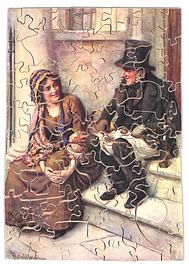

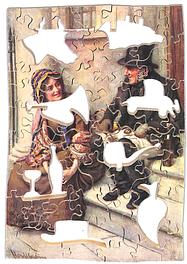
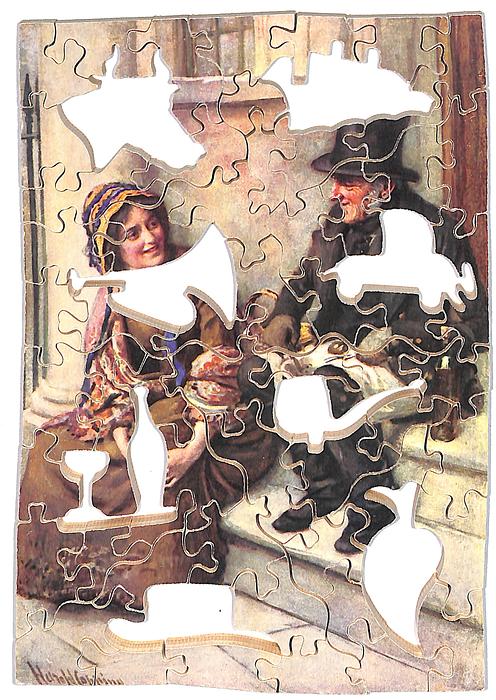
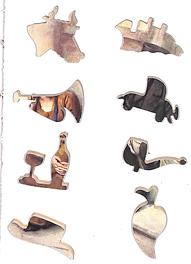



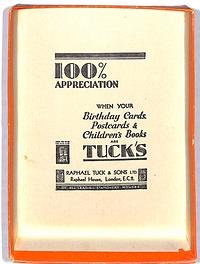
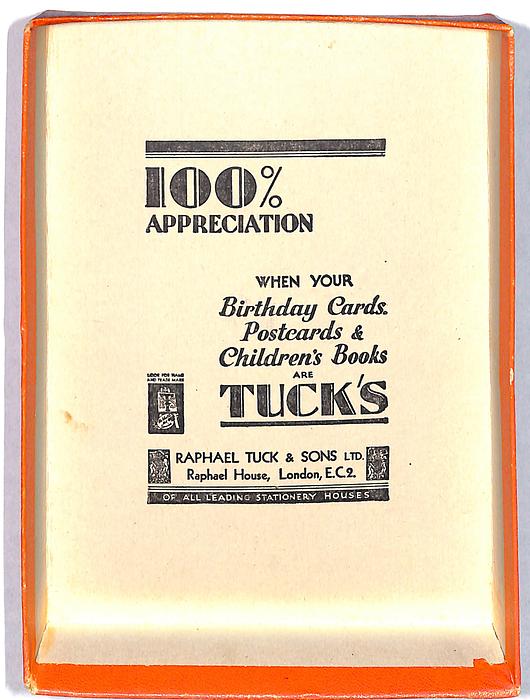
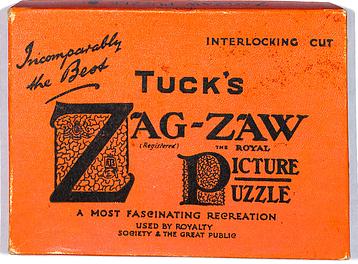
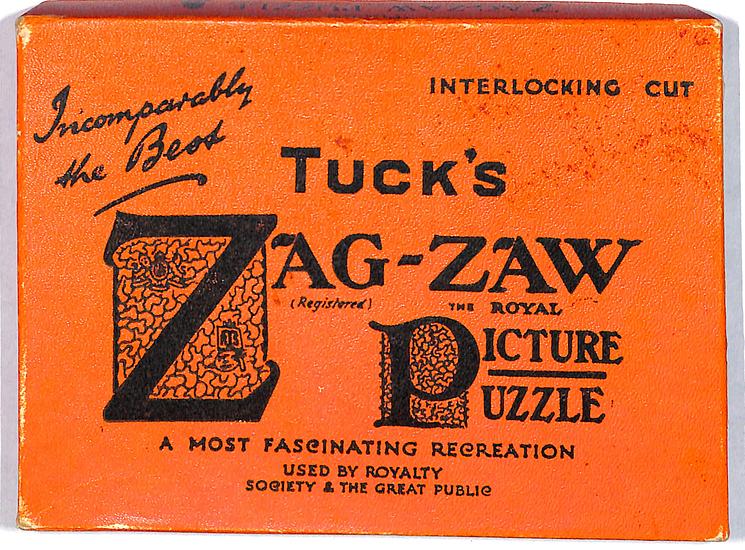
|
about 65 pieces, wooden, figurals, complete with box, interlocking style
|
|
|
|
Zag-Zaw line of puzzles was first produced in 1909, most incorporate figurals or whimsies, sold in red, orange, or occasionally green boxes with labels on the side or bottom of the box, most without guide pictures. Initially cut non-interlocking but by 1930's became more so. Puzzles have a different cuts so that the same image will come in several versions which means that missing pieces can not be taken from other puzzles with the same image. The puzzle labels are often hand written and come with minor variations in titles and details. Some have a DESIGN catergory on the label. From my readings this refers to the style of cut, wavy lines, figurals, etc. See also Bob Armstrong's website on old jigsaw puzzles
|
HAROLD COPPING
|
|
5 x 7 in.
|
|
| ||||
| 94 |

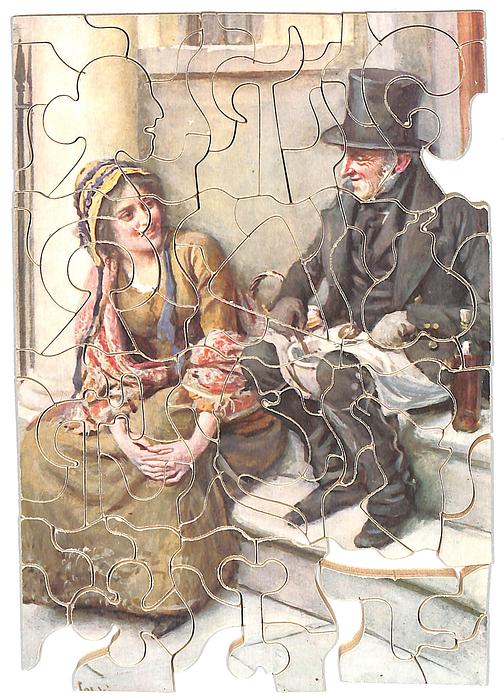
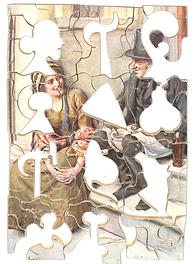

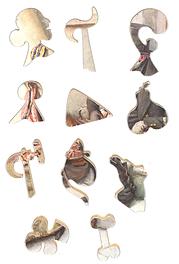
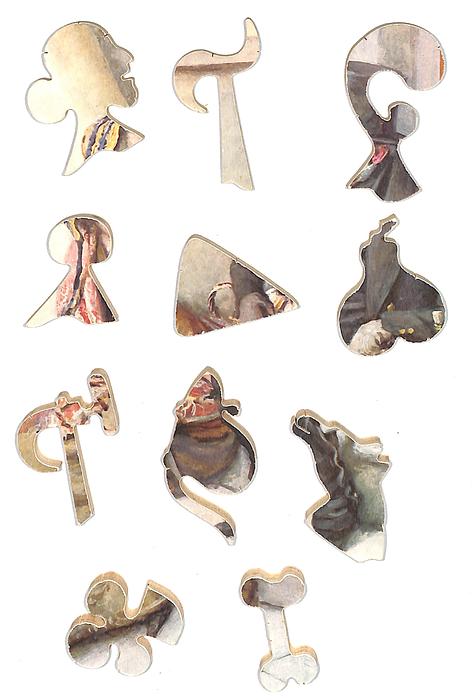
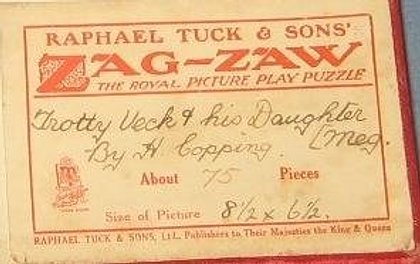
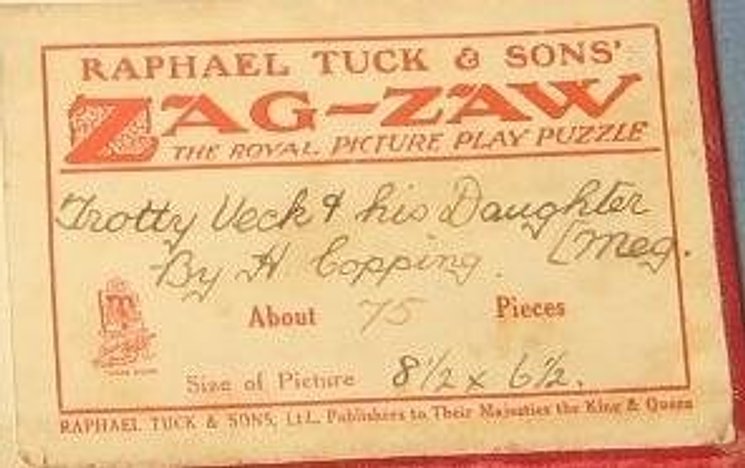
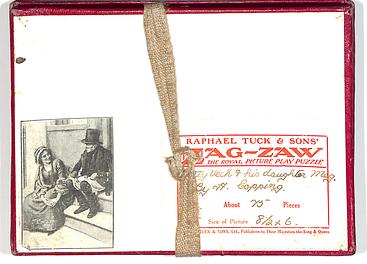

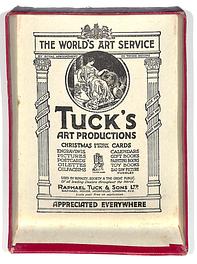

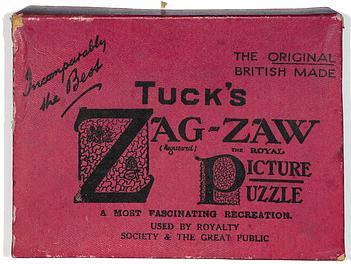

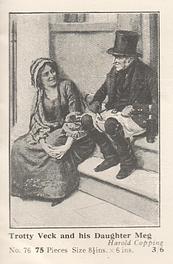
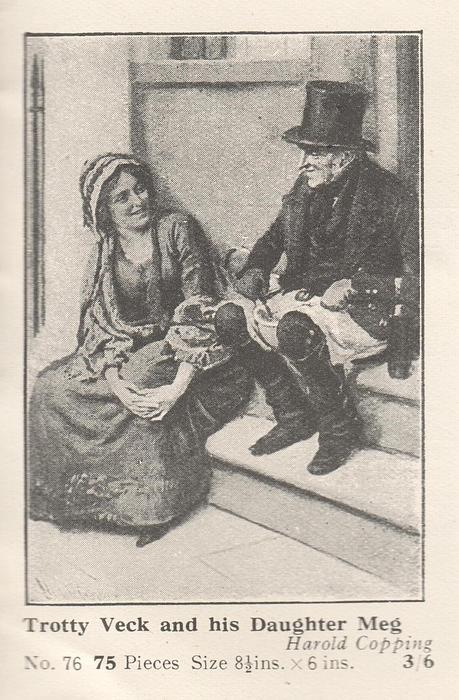
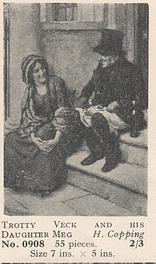
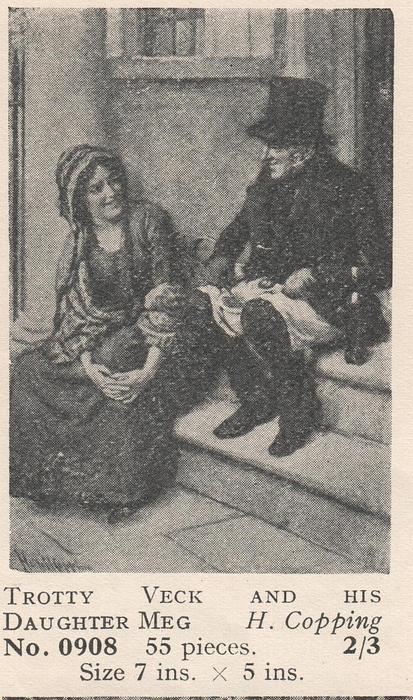
|
75 pieces, wooden, figurals, with box, missing pieces, described and listed in the catalogs as number 76 and 0908 depending on the catalog
|
|
|
|
Zag-Zaw line of puzzles was first produced in 1909, most incorporate figurals or whimsies, sold in red, orange, or occasionally green boxes with labels on the side or bottom of the box, most without guide pictures. Initially cut non-interlocking but by 1930's became more so. Puzzles have a different cuts so that the same image will come in several versions which means that missing pieces can not be taken from other puzzles with the same image. The puzzle labels are often hand written and come with minor variations in titles and details. Some have a DESIGN catergory on the label. From my readings this refers to the style of cut, wavy lines, figurals, etc. See also Bob Armstrong's website on old jigsaw puzzles
|
H. COPPING
|
|
6 x 8 1/2 in.
|
|
| ||||
| 95 |
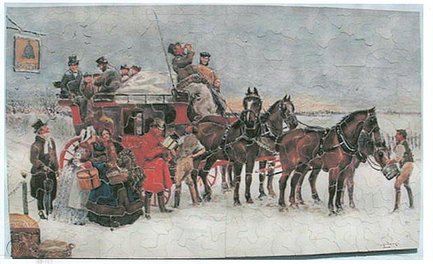
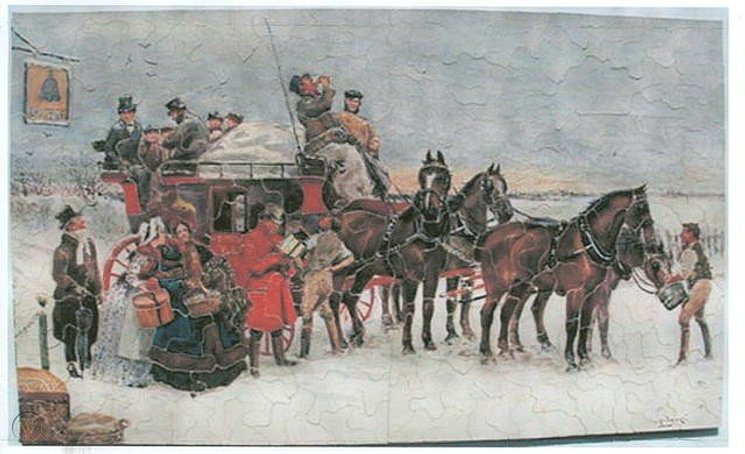
|
757 pieces, early Tuck with NO figurals, interlocking
|
|
|
|
Zag-Zaw line of puzzles was first produced in 1909, all incorporate figurals or whimsies, sold in red or orange boxes with labels on the side or bottom of the box, most without guide pictures. Initially cut non-interlocking but by 1930's became more so. Puzzles have a different cuts so that the same image will come in several versions which means that missing pieces can not be taken from other puzzles with the same image. See also Bob Armstrong's website on old jigsaw puzzles
|
A. LUDOVICI
|
|
|
|
|